In the sun-drenched landscapes of Arizona, the flitting hummingbirds bring a burst of color and vitality. These tiny birds are a delightful sight to behold as they dart between plants, sipping nectar with their slender beaks. In Arizona, you can find various types of these fascinating hummingbirds, each with their own favorite floral havens.
In this article, we will introduce you to different hummingbird species found in Arizona and the plants they absolutely adore. If you’re a bird enthusiast or just someone who enjoys the simple pleasures of nature, discover the harmonious relationship between these birds and their beloved plants.
Types of Hummingbirds In Arizona
In Arizona, you have the chance to spot these 10 and many more types of hummingbirds in their natural surroundings.
1. Anna’s Hummingbird (Calypte anna)

A beautiful sight, Anna’s hummingbird is one of the most common hummingbirds you’ll see in Arizona.
©yhelfman/Shutterstock.com
Anna’s hummingbirds are truly a visual delight, often spotted with green and gray colors. It’s fairly easy to tell apart the males from the females by paying attention to the coloration around their neck area. Notably, the males sport a dazzling rose-pink hue on their heads and throats. Females generally exhibit a duller gray tone, although some may display sporadic red markings on their heads. These hummingbirds measure about 3 to 4 inches in length. In terms of diet, Anna’s hummingbird generally feeds on nectar from a huge range of plants, but they have a particular preference for currant and gooseberry.
These particular hummingbirds are native to Arizona and are often found in large numbers throughout the state. Their presence is notable mainly in central and southern parts of Arizona, where they are frequent visitors to backyard feeders, especially in the Sonoran Desert.
While they are mainly seen during the spring season, it is not uncommon to spot them at any time of the year within most parts of their Arizona habitat.
2. Broad-Billed Hummingbird (Cynanthus latirostris)

Another colorful hummingbird species in Arizona, broad-billed hummingbirds have a shiny green body and a striking blue neck.
©Monir Hossain/iStock via Getty Images
Broad-billed hummingbirds are among the most colorful species found in Arizona. These radiant creatures are a feast for the eyes. In particular, males showcase a shiny green body complemented by a striking blue neck and chest area. This blue color stretches all the way down to their upper belly, creating a captivating visual. The females, on the other hand, have a more subdued coloration, particularly in the belly region.
Typically, broad-billed hummingbirds measure between 3.2 and 3.8 inches in length. This hummingbird species drinks nectars from a variety of flowers and homemade feeders, too. Every now and then, they will supplement their diet with insects.
Predominantly migrating from Mexico between March and October to mate, these hummingbirds have chosen the oak-rich canyons of southern Arizona as their breeding grounds. Lately, they have been venturing further north, marking their presence in the lush riparian zones of north-central Arizona. Although they can be seen frequenting feeders at various times during the day, they seem to enjoy lengthier feeding sessions as the sun sets. Interestingly, these hummingbirds nest quite close to the ground.
3. Black-Chinned Hummingbird (Archilochus alexandri)

As evidenced by their common name, black-chinned hummingbirds have a prominent black neck area.
©rck_953/Shutterstock.com
Black-chinned hummingbirds boast a shimmering green color complemented by a grayish-white lower section. The males have a prominent black neck area coupled with a hint of purple near the base. On the other hand, females exhibit a lighter coloration, particularly in the neck region, and have white-tipped feathers.
This particular species of hummingbird measures about 3.25 inches in length. As with most other hummingbirds, the black-chinned hummingbird eats a combination of nectar, sugar water in feeders, and tiny insects for some protein.
These fascinating native birds of Arizona are most frequently spotted between April and September, after which they head to Mexico to spend the winter months. Recognized for their remarkable adaptability, black-chinned hummingbirds are at home in diverse environments ranging from lofty mountain grasslands to elevated desert regions and occasionally even lower altitudes.
They aren’t as abundant as Anna’s hummingbirds in Arizona. But there is still a fair probability of crossing paths with a black-chinned hummingbird in various state parks or even in home gardens and backyard feeders.
4. Broad-Tailed Hummingbird (Selasphorus platycercus)

The broad, rounded tail of the broad-tailed hummingbird is its identifying feature.
©Susan Hodgson/Shutterstock.com
Broad-tailed hummingbirds are a remarkable sight in Arizona. Males are identifiable by their red beaks, a body that shines with an iridescent emerald hue, and a striking blue neck area. Additionally, they possess wings that bear a brownish color, complemented by a pale color along the chest region. In contrast, females and young ones stand out with their green-speckled neck areas. Both male and female broad-tailed hummingbirds have, as evidenced by their name, a broad, rounded tail.
This hummingbird has a body length of approximately 3.6 inches and a wingspan of 5.3 inches. Broad-tailed hummingbirds pretty much exclusively feed on nectar.
These birds, often seen as seasonal visitors, have a portion of their population nesting in certain areas of southern Arizona, while others pass through the region during their northward migration. They are residents of Guatemala and Mexico for a significant part of the year. But they have a noticeable presence in various parts of Arizona from March to August.
Their preferred breeding spots are meadows located at higher elevations, amidst coniferous trees, and in the vicinity of mixed pine-oak woodlands.
5. Costa’s Hummingbird (Calypte costae)

Costa’s hummingbirds are certainly one of the most striking birds in Arizona.
©Rick Scuteri/Shutterstock.com
One of the most beautiful hummingbirds in Arizona is the Costa’s hummingbird. Costa’s hummingbirds are easily identified by their incredibly brightly-colored violet throats and crowns, green backs, and contrasting white abdomens. Furthermore, their flanks have greenish tones. Male and female birds can be differentiated through the coloration of their abdomen; females lack the bright purple gorget and instead showcase a paler belly with lesser purple tones compared to males.
Costa’s hummingbird measures around 3.6 inches in length and weighs just 2 to 4 grams. The variety of this hummingbird’s diet is made up of nectar.
These fast and territorial hummingbirds are native to Arizona, captivating onlookers with their spirited aerial performances and bold demeanor, especially when protecting their territories around feeding areas and parks. A substantial number of these birds migrate into the state from the coastal areas of Mexico. But through and through, Costa’s hummingbirds are desert birds.
6. Rufous Hummingbird (Selasphorus rufus)
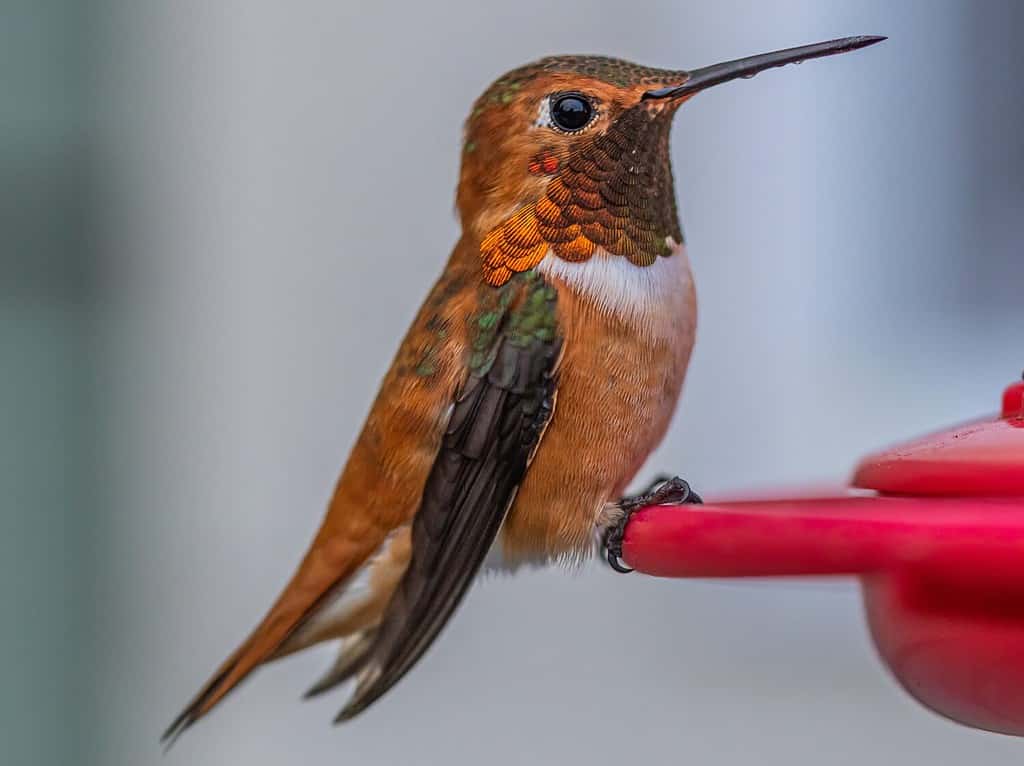
As evidenced by their name, rufous hummingbirds are rust-colored.
©Panduh Productions/Shutterstock.com
Male rufous hummingbirds mainly showcase a rust-colored plumage with a brilliantly metallic, coppery throat area. You might also spot sporadic green specks adorning the feathers on their back, wings, and abdomen. In contrast, the females exhibit a similar rust tone on their lower bodies but are decked with green hues on their crowns and backs. Additionally, flecks of green can be observed on the females’ neck region.
These birds measure just slightly above 3 inches in length and weigh between 2 and 4 grams. Rufous hummingbirds love to feed on nectar, so they may be a common sight on backyard feeders. However, much like the Costa’s hummingbird, rufous hummingbirds are known for their aggressive nature, readily pursuing and chasing other birds away from feeders, regardless of their size, if they perceive any form of threat.
These hummingbirds visit Arizona as seasonal migrants, marking a presence during their autumnal journey between July and October as they traverse the state. While they are also visible during their spring travels in March and April, their numbers are fewer during this period.
7. Calliope Hummingbird (Selasphorus calliope)
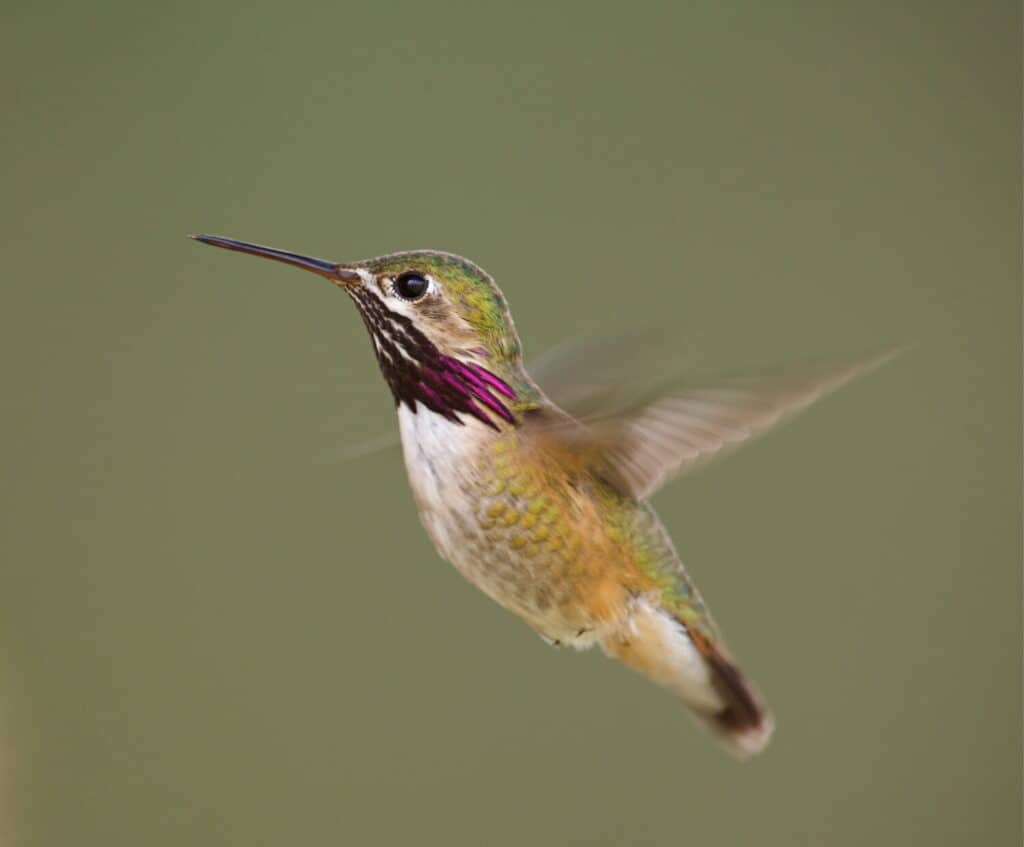
Often mistaken for broad-tailed hummingbirds, calliope hummingbirds are much smaller in size.
©Tom Reichner/Shutterstock.com
Calliope hummingbirds are frequently mistaken for broad-tailed hummingbirds. However, they are much smaller. In fact, calliope hummingbirds are often considered the smallest hummingbird species in Arizona. In terms of appearance, the males are characterized by a magenta throat, dark plumage on the tail, and a shimmering green back. Females, on the other hand, exhibit a less pronounced color on their throat and have a white underpart with subtle pink hues.
Their size typically does not exceed a length of 3.7 inches, and they have a relatively varied diet, feeding on nectar or eating tiny insects that they pick up from or near flowers and plants.
Calliope hummingbirds are seasonal visitors in Arizona, seen mainly during their migratory periods. They are often sighted in locations like the Coconino National Forest, the Grand Canyon, and in southeastern regions near Tucson. When it comes to nesting, these hummingbirds prefer to establish their homes on evergreen trees.
Interestingly, despite their size, calliope hummingbirds have an incredibly long migration route, spending their winters in Mexico and migrating up the Pacific coast as the weather warms up. And in the fall, they’ll return to Mexico via the Rocky Mountains.
8. Blue-Throated Hummingbird (Lampornis clemenciae)
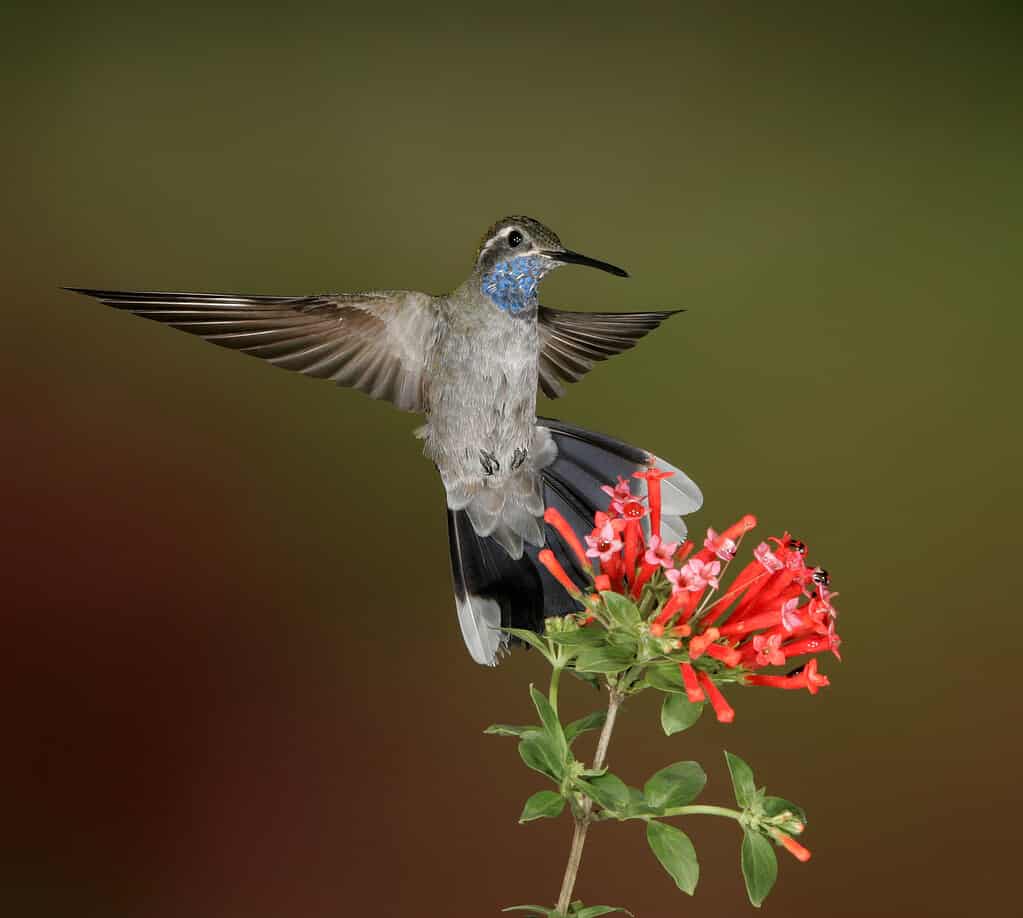
Blue-throated hummingbirds are larger than other hummingbirds, almost 5 inches in size!
©Jedlovec/ via Getty Images
Adult male blue-throated hummingbirds have a bronzy green color. Upon close inspection, you can observe white streaks above and below their eyes. Their throat showcases a sparkling blue shade, which tends to darken under subdued light. In contrast, the females share these characteristics, except for the blue throat.
In terms of size, this bird stands out as considerably larger than other hummingbirds, potentially reaching up to 4.9 inches in length and weighing around 10 grams. Besides their usual diet of nectar, blue-throated hummingbirds will also hunt for insects like spiders and plant lice.
Blue-throated hummingbirds establish their breeding grounds in the mountainous regions of southeastern Arizona. These birds inhabit areas abundant in flowers, situated at elevations ranging from 4,000 to 12,000 feet. They prefer residing near flowing waters, in forested regions, and within the chilly environments of coniferous habitats.
9. Violet-Crowned Hummingbird (Amazilia violiceps)
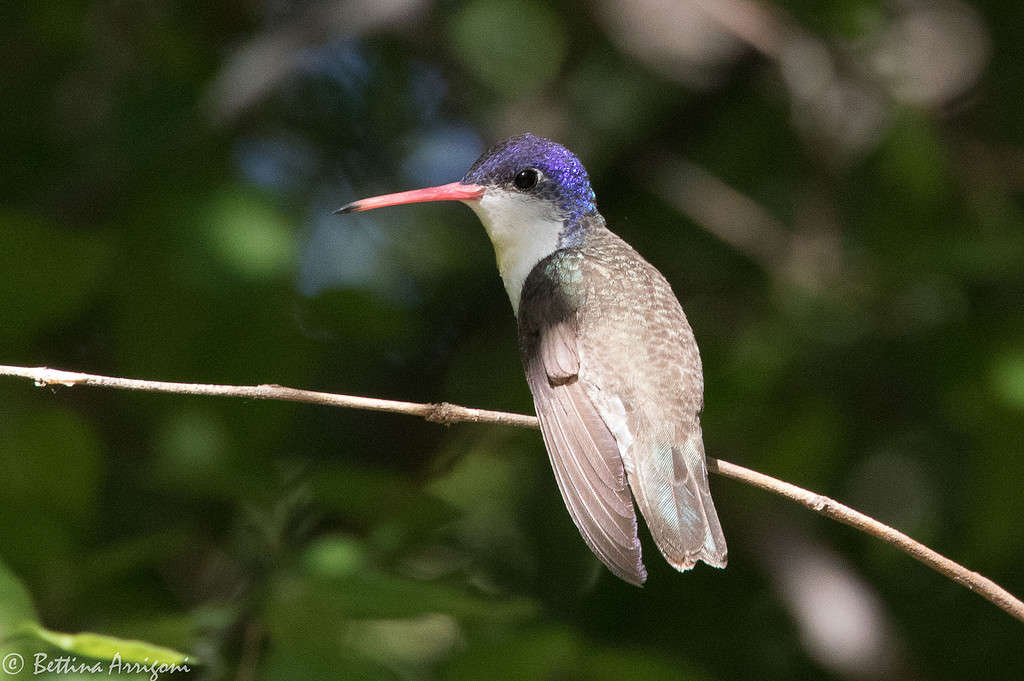
Violet-crowned hummingbirds boast a violet crown.
©Bettina Arrigoni / CC BY 2.0 – License
As with most other hummingbirds, the female violet-crowned hummingbird possesses a more subdued color compared to the male. True to their name, these birds sport a violet crown, red beak, and white underparts. Uniquely, the males of this species lack the vibrant throat patch that is commonly seen in other hummingbirds.
The length of a violet-crowned hummingbird typically falls between 3.9 and 4.5 inches and will weigh around 5 grams. As with most other hummingbird species, the violet-crowned hummingbird sustains itself on nectar and insects.
In Arizona, the violet-crowned hummingbird is known to breed sporadically, with the peak of nesting activities happening during the later part of the summer monsoon season. While in the past, they were only known to reside in Arizona during the summer, recent trends have shown that a small number have begun to stay throughout the winter.
A significant population of these birds can be spotted in the Madrean Sky Islands, located in the southwestern region of Arizona.
10. White-Eared Hummingbird (Basilinna leucotis)

Both genders of the white-eared hummingbird have a white stripe behind the eyes.
©Gerardo Aguilar Anzures/Shutterstock.com
The white-eared hummingbird can be recognized by its distinct features. Both genders possess a dark face mask, a pronounced white stripe behind the eyes, and a red base on their beaks. While the males exhibit a seemingly dark head and throat, which can shine with violet and green colors under the right lighting. The females are identifiable by their lighter throats and chests, adorned with green speckles.
This bird has a body length ranging from 3.5 to 3.9 inches and weighs about 3.5 grams, with females smaller than males. The majority of their diet is made up of nectar from flowers, sugar water in feeders, and tiny insects.
In the canyons of southern Arizona, especially where feeders for hummingbirds are maintained, it’s not unusual to find solitary white-eared individuals visiting and staying for extended periods. There have been occasional sightings of this species during the summer months in Arizona since the late 19th century.
Plants in Arizona That Attract Hummingbirds
Explore the simple joys of attracting hummingbirds with Arizona’s plants. In this section, we’ll highlight the plants that these delightful birds absolutely love. Your garden may become a hummingbird and pollinator haven in no time!
1. Sunset Hyssop (Agastache rupestris)

Sunset hyssop is one of the most popular plants to attract hummingbirds in Arizona.
©Alex Manders/Shutterstock.com
One of the top plants to lure hummingbirds into Arizona gardens is the sunset hyssop, a tall perennial that features bright spikes of salmon-orange flowers surrounded by purplish bracts from the start of summer until late in the season. These blooms rise above a bed of silvery-green, slender leaves, creating a visual treat.
This plant thrives effortlessly in sunny spots, favoring dry to medium moisture levels in well-draining soil. It doesn’t perform well in damp areas and requires excellent drainage to flourish.
It offers flowers rich in nectar, making it a favorite for visiting hummingbirds as well as bees and butterflies.
2. Chocolate Daisy (Berlandiera lyrata)
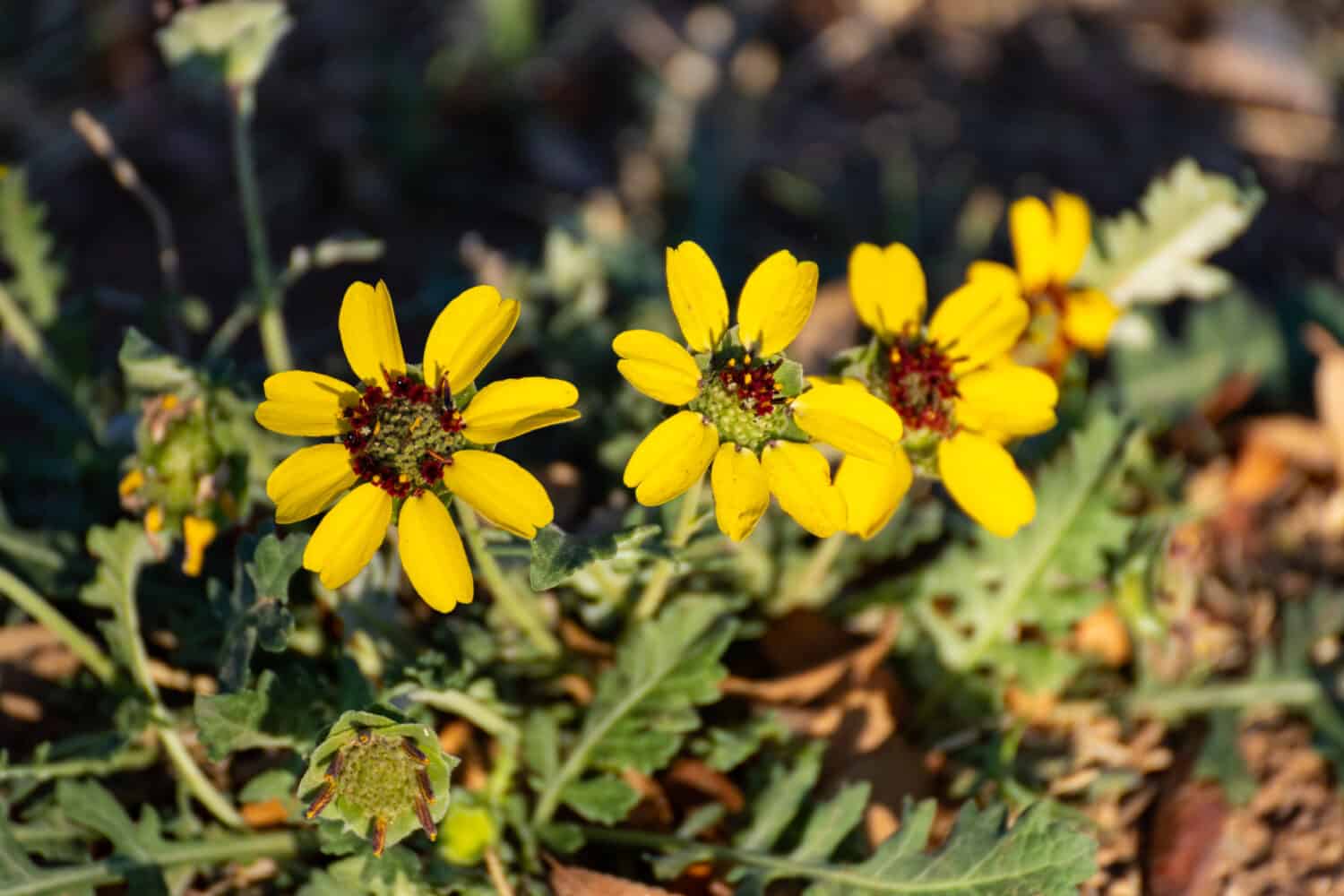
A perennial wildflower, the chocolate daisy smells like chocolate and draws in hummingbirds.
©G B Hart/Shutterstock.com
With a scent of chocolate, the chocolate daisy stands out as a remarkable perennial wildflower native to Arizona. It showcases daisy-like blossoms about 2 inches wide. These blooms feature golden petals encircling a striking maroon center and green bract cups. They grace gardens with colors from late spring all the way to fall, and even year-round in temperate climates.
This plant flourishes best under the full sun, favoring average, dry to moderately moist, well-draining soils. It has a preference for sandy soils and can withstand a bit of shade.
Its flowers, rich in nectar, draw in various pollinators, including bees, butterflies, and, of course, hummingbirds, making it an excellent choice for gardens aiming to support local wildlife.
3. Firecracker Plant (Russelia equisetiformis)

The firecracker plant is perfect for hummingbirds.
©mark higgins/Shutterstock.com
Ideal for Arizona’s warm conditions, the firecracker plant boasts charming orange tube-like blossoms. These are perfect for hummingbirds who slide their beaks inside, slightly open them, and reach the base where the sweet nectar is stored. This unique design mostly caters to hummingbirds, as other creatures can’t access its nectar.
This eye-catching plant, with minimal leaves, drapes beautifully from walls or elevated gardens, presenting a show of red/orange flowers from late spring till fall. In milder climates, it even blooms all year round.
The firecracker plant flourishes best when placed in full to partial sunlight and planted in nutrient-rich, moderately moist, and well-draining soil.
4. Desert Willow (Chilopsis linearis)
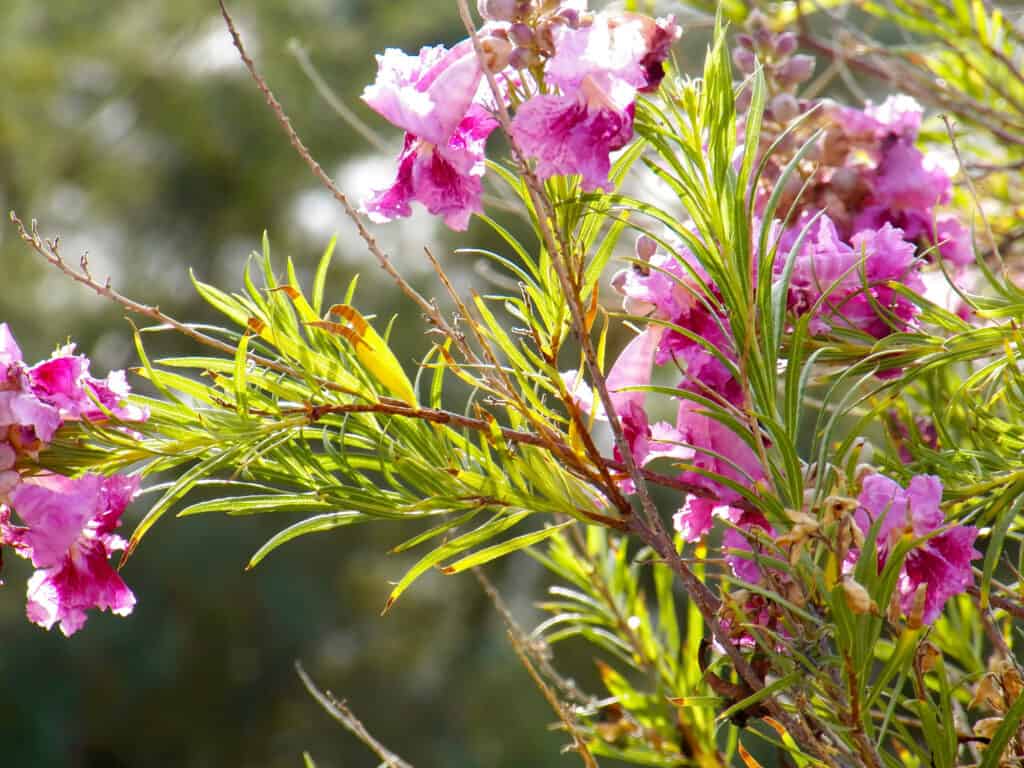
The nectar-rich flowers of the desert willow draw in hummingbirds and other pollinators.
©iStock.com/Yolanda P
The desert willow is a sprawling shrub or a small tree that loses its leaves annually, showcasing slender, willow-like leaves and striking groups of flowers from late spring till fall. These delightful and aromatic trumpet-like blooms, which bring to mind the flowers of a catalpa tree, exhibit a soft color ranging between light pink and violet.
This plant thrives in areas that receive ample sunlight and is planted in well-draining soils. Not only is it highly resilient to drought and heat, but it is also not particular about the soil type it is planted in, managing to grow in various soil conditions.
The nectar-rich flowers of the desert willow are a favorite among hummingbirds and other pollinating insects, making it a delightful addition to any garden.
Where to See Hummingbirds in Arizona
The following places in Arizona provide the most chances to see hummingbirds!
The Paton Center for Hummingbirds is a haven for these delightful birds. Initially, a private residence where the previous owners nurtured a community of hummingbirds, the Tucson Audubon Society recently acquired the property to ensure that bird enthusiasts continue to enjoy the sights of these tiny birds fluttering about for many more years.
Not far from other exciting bird-watching sites in Madera Canyon, the Santa Rita Lodge is a magnet for a variety of hummingbirds, making it a prime spot for bird lovers to visit.
Beatty’s Guest Ranch stands as a top destination in southeast Arizona for spotting the rare white-eared hummingbirds, among many others. This location is renowned for its rich diversity of birds, constantly drawing admirers. In fact, the ranch boasts a record for witnessing the highest number of different hummingbird species in a single day within the U.S., making it a hotspot for catching sight of some rare finds.
For those eager to witness the rare Lucifer hummingbird, Ash Canyon Bird Sanctuary should be on your list. Not only is it home to this specific species, but it also hosts a multitude of other hummingbird species and a wide array of different birds, all flocking to the many feeders situated here.
And don’t overlook the joy of bringing these vibrant birds into your own space. Creating a hummingbird-friendly habitat in your own backyard or garden by planting specific plants or hummingbird feeders is another splendid way to enjoy their presence in Arizona.
Summary of Hummingbirds in Arizona
| Number | Hummingbird | Scientific Name |
|---|---|---|
| 1. | Anna’s Hummingbird | Calypte anna |
| 2. | Broad-Billed Hummingbird | Cynanthus latirostris |
| 3. | Black-Chinned Hummingbird | Archilochus alexandri |
| 4. | Broad-Tailed Hummingbird | Selasphorus platycercus |
| 5. | Costa’s Hummingbird | Calypte costae |
| 6. | Calliope Hummingbird | Selasphorus calliope |
| 7. | Blue-Throated Hummingbird | Lampornis clemenciae |
| 8. | Violet-Crowned Hummingbird | Amazilia violiceps |
| 9. | White-Eared Hummingbird | Basilinna leucotis |
The photo featured at the top of this post is © yhelfman/Shutterstock.com
Thank you for reading! Have some feedback for us? Contact the AZ Animals editorial team.






